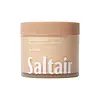What's inside
What's inside
 Key Ingredients
Key Ingredients

 Benefits
Benefits

 Concerns
Concerns

 Ingredients Side-by-side
Ingredients Side-by-side

Water
Skin ConditioningCocos Nucifera Oil
MaskingCaprylic/Capric Triglyceride
MaskingGlycerin
HumectantOctyldodecyl Myristate
EmollientCetyl Alcohol
EmollientDimethicone
EmollientGlyceryl Stearate
EmollientBehenyl Behenate
EmollientBehenyl Alcohol
EmollientParfum
MaskingLinoleic Acid
CleansingPhospholipids
Skin ConditioningPhytosterols
Skin ConditioningVitis Vinifera Seed Oil
EmollientSimmondsia Chinensis Seed Oil
EmollientHippophae Rhamnoides Seed Oil
Skin ProtectingHydrogenated Lecithin
EmulsifyingCeramide NP
Skin ConditioningCeramide As
Skin ConditioningCeramide Ns
Skin ConditioningCeramide EOP
Skin ConditioningCeramide AP
Skin ConditioningPolyacrylate Crosspolymer-6
Emulsion StabilisingPhenoxyethanol
PreservativeEthylhexylglycerin
Skin ConditioningPolyhydroxystearic Acid
EmulsifyingPolyglyceryl-10 Stearate
Skin ConditioningSodium Stearoyl Lactylate
EmulsifyingEuphorbia Cerifera Wax
Ascorbic Acid
AntioxidantTocopheryl Acetate
AntioxidantTocopherol
AntioxidantLinalool
PerfumingBenzyl Salicylate
PerfumingHexyl Cinnamal
PerfumingAlpha-Isomethyl Ionone
PerfumingLimonene
PerfumingWater, Cocos Nucifera Oil, Caprylic/Capric Triglyceride, Glycerin, Octyldodecyl Myristate, Cetyl Alcohol, Dimethicone, Glyceryl Stearate, Behenyl Behenate, Behenyl Alcohol, Parfum, Linoleic Acid, Phospholipids, Phytosterols, Vitis Vinifera Seed Oil, Simmondsia Chinensis Seed Oil, Hippophae Rhamnoides Seed Oil, Hydrogenated Lecithin, Ceramide NP, Ceramide As, Ceramide Ns, Ceramide EOP, Ceramide AP, Polyacrylate Crosspolymer-6, Phenoxyethanol, Ethylhexylglycerin, Polyhydroxystearic Acid, Polyglyceryl-10 Stearate, Sodium Stearoyl Lactylate, Euphorbia Cerifera Wax, Ascorbic Acid, Tocopheryl Acetate, Tocopherol, Linalool, Benzyl Salicylate, Hexyl Cinnamal, Alpha-Isomethyl Ionone, Limonene
Water
Skin ConditioningPropanediol
SolventMandelic Acid
AntimicrobialPolysorbate 20
EmulsifyingGlycerin
HumectantGluconolactone
Skin ConditioningLactic Acid
BufferingNiacinamide
SmoothingXylityl Sesquicaprylate
AntimicrobialAnhydroxylitol
HumectantPanthenol
Skin ConditioningPotassium Hydroxide
BufferingHydroxyethylcellulose
Emulsion StabilisingSodium Benzoate
MaskingCitric Acid
BufferingSodium Phytate
Benzoic Acid
Masking
 Reviews
Reviews

Ingredients Explained
These ingredients are found in both products.
Ingredients higher up in an ingredient list are typically present in a larger amount.
Glycerin is already naturally found in your skin. It helps moisturize and protect your skin.
A study from 2016 found glycerin to be more effective as a humectant than AHAs and hyaluronic acid.
As a humectant, it helps the skin stay hydrated by pulling moisture to your skin. The low molecular weight of glycerin allows it to pull moisture into the deeper layers of your skin.
Hydrated skin improves your skin barrier; Your skin barrier helps protect against irritants and bacteria.
Glycerin has also been found to have antimicrobial and antiviral properties. Due to these properties, glycerin is often used in wound and burn treatments.
In cosmetics, glycerin is usually derived from plants such as soybean or palm. However, it can also be sourced from animals, such as tallow or animal fat.
This ingredient is organic, colorless, odorless, and non-toxic.
Glycerin is the name for this ingredient in American English. British English uses Glycerol/Glycerine.
Learn more about GlycerinWater. It's the most common cosmetic ingredient of all. You'll usually see it at the top of ingredient lists, meaning that it makes up the largest part of the product.
So why is it so popular? Water most often acts as a solvent - this means that it helps dissolve other ingredients into the formulation.
You'll also recognize water as that liquid we all need to stay alive. If you see this, drink a glass of water. Stay hydrated!
Learn more about Water